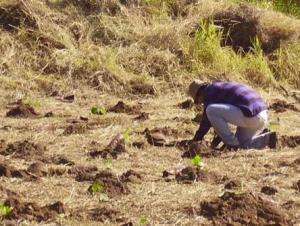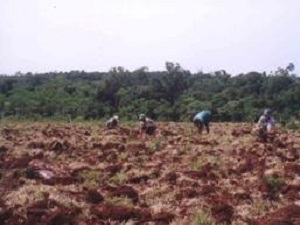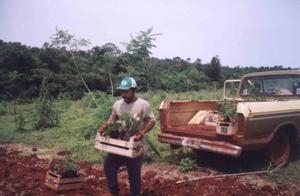Overview
This project was initiated in 2001 with the support of the World Wildlife Fund (WWF) and its partner organization the Fundación Vida Silvestre Argentina (FVSA) to reconnect and restore fragmented stands of Atlantic Forest in the tri-national Upper Paraná eco-region of Argentina, Brazil and Paraguay. This region is of vital importance in maintaining connectivity among four key parks: Iguaúu National Park in Brazil, Iguazú National Park in Argentina (both Heritage Sites protecting the world famous Iguazú Falls), and the Urugua-í and Foerster Provincial parks of Misiones, Argentina. Restoration treatments have targeted privately owned agricultural land representing a dangerous bottleneck for biodiversity, and more than 20 hectares are currently being restored in the municipality of Andresito. Not only have experimental trials allowed practitioners to evaluate the efficacy of different techniques, the project has yielded extensive data on the dynamics of native species regeneration and has facilitated collaborative relationships with local agricultural producers. Alternatives for sustainable land management are being explored (i.e. organic and under-story yerba mate production), and it is hoped that this project will serve as a regional model for balancing the livelihoods of local communities with the needs of vital forest habitats.
Quick Facts
Project Location:
-25.683187, -54.454701
Geographic Region:
Latin America
Country or Territory:
Argentina
Biome:
Tropical Forest
Ecosystem:
Tropical Forest - Moist Broadleaf
Area being restored:
20 hectares
Project Lead:
World Wildlife Fund (WWF) and Fundación Vida Silvestre Argentina (FVSA)
Organization Type:
NGO / Nonprofit Organization
Location
Project Stage:
Implementation
Start Date:
2001-08-27
End Date:
2008-08-27
Primary Causes of Degradation
Agriculture & Livestock, Deforestation, FragmentationDegradation Description
The Upper Paraná region of the Atlantic Forest once covered approximately 471,000 square kilometers of northern Argentina, eastern Paraguay, and southwestern Brazil. Today only 7.81 percent of the original forest cover remains. Primary causes of ecosystem degradation and fragmentation include soy bean cultivation, cattle ranching, yerba mate plantations, and monoculture plantations of exotic tree species (principally Pinus spp., Eucalyptus spp., and Araucaria angustifolia). The provincial government of Misiones estimates that between 1992 and 2003, the area under cultivation increased from 7300 ha to 283,000 ha.
Reference Ecosystem Description
In spite of its highly fragmented condition, the Atlantic Forest remains one of Earth’s most biologically diverse ecosystems, containing about 7% of the world’s species. The southwestern portion of the Atlantic Forest encompasses the Upper Paraná Atlantic Forest eco-region and extends along southwestern Brazil to eastern Paraguay and the Misiones Province of northeastern Argentina. This tri-national eco-region has the largest remaining forest blocks and provides rich habitat that still harbors the jaguar (Panthera onca), puma (Felis concolor), and ocelot (Felis pardalis). Other common mammals include the tapir (Tapirus terrestris), coati (Nasua nasua), and four species of monkeys (Cebus apella nigritus, Alouatta caraya, Alouatta fusca fusca, and Leontopithecus chrysopygus). In addition, about 500 species of birds are found here, including five species of toucans. The Upper Paraná Atlantic Forest eco-region also constitutes an important source of freshwater and plays an important role in the conservation of watersheds.
Project Goals
–To evaluate the ecological and economic efficiency of different forest restoration techniques.
–To develop a recovery model of forest productivity based on the sustainable use of palmito (Euterpe edulis) and yerba mate (Ilex paraguariensis), two species with considerable importance for local livelihoods.
–To restore forest cover in target areas and thus help re-establish connectivity among isolated patches.
–To develop and test monitoring methods applicable in landscape-scale restoration projects.
–To capacitate local community members in forest restoration and rehabilitation practices and techniques.
Monitoring
The project does not have a monitoring plan.
Stakeholders
Training and public outreach targeting local landowners and community members has been a top priority throughout this restoration effort, as practitioners hope to raise awareness in the region and encourage restoration and conservation activities on neighboring farms. Project results and alternative farm management strategies have been reported to members of the Organic Agriculture Net, the Ecology and Natural Resources Ministry of Misiones Province, and local producers from around the area.
Meetings were organized in 2006 with members of the Yerbatera Yapeyú Cooperative to discuss a variety of topics related to farm management, and some member producers have since begun implementing agro-ecological practices on their farms (i.e. using native tree species). These farms were visited by project staff to obtain firsthand knowledge of the producers’ experiences and assess the efficacy of agro-ecological management in the study area. The visits also aided practitioners in determining which farms were most appropriate for further rounds of discussion and technical support.
Through these and other networking and training activities, practitioners hope to secure the active and on-going participation of local producers and achieve a gradual restructuring of farm management practices such that biodiversity and forest conservation go hand-in-hand with local agricultural productivity.
Description of Project Activities:
This project is concerned with testing and evaluating several different restoration techniques in order to determine the extent to which different factors and processes influence the regeneration of these native forests and which restoration treatments are most effective in accelerating its recovery. The treatments thus far implemented have focused on eliminating "barriers" for regeneration (e.g. herbivory, compacted soils, agriculture, etc.) and have been carried out primarily on abandoned grazing lands, forest edges invaded by prolific native species, and yerba mate plantations. Fieldwork was conducted in Andresito and Eldorado (Misiones Province) on local farms belonging to different families of producers.
A tree nursery was constructed in 2001 on a farm in the study area, and local producers from Andresito and Eldorado were trained in the production of native species saplings and plantations. Other local community members, who were specially hired for this area, were trained in the installation of restoration treatments and their monitoring.
Four abandoned pasturelands were treated by first eliminating grasses (identified as a barrier for regeneration) using a machete over the entire plot. High densities of rapid growth pioneer species were then planted, along with seedlings of native trees produced in the nursery. These species are functioning as regeneration "facilitators," creating shade to decrease grass cover and encouraging the colonization of other tree species (Holz y Placci, 2006). Clean-up of planted sites was carried out periodically (as demanded by grass growth) by hoeing within a radius of 30 cm around each sapling.
These treatments are intended to ascertain the density of pioneer species necessary to inhibit grass growth and stimulate natural regeneration, as well as to determine the effectiveness of eliminating grasses from treated plots at the outset of restoration.
The regeneration of border areas in forest fragments was another focus of the project. These "edges" are generally overgrown with native invasive species, such as "tala" (Celtis spp.) and bamboo (Chusquea ramosissima and Merostachys clausenii), which impair regeneration and emphasize the "border effect." Management of border areas is an important component of restoration planning, as it not only decreases the border effect in given patch, but also mitigates the species imbalance in the larger forest "matrix." Although borders are generally considered unproductive areas, clearing them of invasive species may help increase their profitability, as it encourages the natural regeneration of more marketable species (e.g. palmetto--used for palm hearts) and provides space for shade-tolerant cultivates such as yerba mate or pineapple.
Two different trials were conducted in forest edges to test these projected outcomes. In the first, "tala" was cleared and crops of yerba mate planted in order to evaluate the production of yerba mate in cleared edges and in plots with forest cover. In the second, bamboo was cleared to assess rates of natural regeneration and determine whether the sowing of palm seeds was necessary to increase density at these rehabilitated edges.
The last type of treatment conducted by practitioners was plantation of native species in "yerbales"--monoculture plantations of yerba mate (Ilex paraguariensis). Although it is currently cultivated as a monoculture, yerba mate is a native tree species that once formed dense patches within the jungle, until they disappeared as a result of overexploitation (Devoto y Rotkugel, 1936). This is a species that can develop in the shade of other trees, and since yerba mate production is one of the most important economic activities in the region, native tree plantations on yerba mate fields afford many benefits. The cover of native forest is increased while simultaneously improving the profitability of yerba mate fields because yerba mate production can be complemented by firewood and timber production. Moreover, soil quality is enhanced by the increased organic matter and nutrient potential.
Trials were conducted in yerbales to evaluate native species growth and survival within these systems and to assess the effect of these plantations on yerba mate production.
Ecological Outcomes Achieved
Eliminate existing threats to the ecosystem:
Most species planted on the abandoned grazing lands showed a high rate of survival (between 75% and 100%) or a medium rate of survival (between 25 and 50%). Relatively few species showed low survival rates (between 25 and 50%). Only Euterpe edulis showed very low survival rates (lower than 25%).
It was observed in the trials affecting forest borders that the areas where "tala" was eliminated were speedily colonized by native trees of rapid growth--principally Trema micrantha and Solanum verbascifolium. Recent monitoring has evidenced a great number of saplings of other species of native trees now growing in these places as well. Tala removal with bulldozer and rake has proven efficient, as few tala saplings have been found and the invasion seems to have been stopped. Given the invading capacity of this species, however, the long-term efficiency of this method remains to be seen.
The edges where lianas and bamboos were cleared have not regenerated to date. However, during quick monitoring, a very important increase in natural regeneration of native tree saplings was observed.
The results of trials at yerba plantations seem promising. The plantations that were not weeded over long periods showed considerable natural regeneration in the yerba rows, and during quick monitoring rounds, several saplings of native species were seen growing among yerba mate plants. It is worth mentioning that moisture and lower temperatures are better kept in yerba rows than in the rest of the yerba mate plantation. This fact, coupled with lower trampling and weeding impact on the site, could aid natural regeneration and make yerba plants "regeneration nuclei" within these systems.
Factors limiting recovery of the ecosystem:
Results obtained through intensive monitoring at the abandoned grazing fields suggest that the negative effect of grass on seedling survival may be of varying intensity depending on the dominant grass type in the matrix. At the studied sites, sapling survival was lower on the parcels dominated by Urochloa decumbens and Urochloa brizantha--both exotic species identified as invasive--than on parcels covered mainly by Axonopus compressus and Paspalum urvillei.
On the other hand, it also seems that species are affected by grass in different degrees. On the parcels dominated by signal grass, all species were significantly affected; whereas on the other parcels, it was observed that the survival of the pioneer species Solanm verbascifolium was higher compared to species of later successional stages (Peltophorum dubium and Balfourodendron riedelianum). Survival of Luehea divaricata (intermediate successional stages) was higher than that of the pioneer species Trema micrantha.
As regards growth, results showed that the presence of grass negatively affected the growth of tree saplings, which coincides with the findings of other researchers (Holl, 2000). However, it did not influence the T. micrantha as much as other species. Although trials only reflect the "net" effect of grass competition--and not the "interference" mechanisms (e.g. shadowing, nutrients limitation, allelopathy, etc.)--looking at studies carried out in other areas, these results are mainly explained by competition between grass and saplings for nutrients (Buschbacher et al., 1988; Nepstad, et al., 1990; Reiners et al., 1994) and water (Ashton et al., 1998).
Yerba mate saplings planted during forest edge treatments exhibited high rates of mortality. This high mortality is mainly attributable to a strong drought that occurred during late spring 2003 and the summer of 2004. Surviving yerba saplings have grown slowly and have larger and thicker leaves than those found in traditional open-air single crops.
Plantations of native tree species in yerba mate monocultures exhibited considerable mortality. Sapling mortality occurred primarily during yerba mate harvesting and as a result of weeding. In 2004, all treatments were planted anew in order to compensate for dead saplings and thus maintain the initial density of the sites. As in the grazing land plantation, saplings that were smaller in size when planted died in larger numbers. However, some saplings deemed dead during quick monitoring later sprouted new shoots and continued growing.
Socio-Economic & Community Outcomes Achieved
Economic vitality and local livelihoods:
Andresito producers keep growing saplings of native species for their own farms and for trade. Through the management of local NGOs, they have also agreed to sell their "yerba" production to an American company which deals in shade-grown organic "yerba." This will imply a marked increase in their profits, since revenue from the production and sale of organic "yerba" will be three times higher per ton than current earnings. From a conservation standpoint, this initiative is very important since it will allow trees of native species to be planted inside the "yerba mate" monocultures, and thereby contribute to an increase in the surface area of the forest.
Key Lessons Learned
If the results of this project are compared with those described in other studies in the ecoregion (Holz et al., 2001; Stutz de Ortega, 1987), after 20-30 years of natural regeneration, the structural characteristics of secondary forest (i.e. basal area, aboveground biomass, etc.) should be expected to approach those of the older forest. In fact, such rapid recovery of structural parameters has been recorded in various studies carried out in tropical secondary forests (Saldariaga et al., 1988; Denslow y Guzman, 2000; Peña-Claros, 2003; Muñiz-Castro et al., 2006). Several authors have pointed out that in secondary forests, vegetation picks up fast and the nutrients it feeds on are soon returned to the land through leaves falling and decomposing, which makes them highly productive systems (Brown y Lugo, 1990; Feldpausch et al., 2004).
In spite of these findings, management and intervention in the early stages of natural regeneration would be an effective and economic way of ensuring a more expeditious and complete restoration of slightly degraded areas. Periodic monitoring and subsequent management would then follow and would facilitate an adaptable and responsive approach that removed obstacles to forest regeneration and encouraged a sustainable relationship between local communities and their surrounding natural resources.
Long-Term Management
Practitioners are working closely with the Yerbatera Yapeyú Cooperative of small-scale yerba mate producers to implement some of the production/restoration models developed through this and other similar projects on their farms. A series of meetings and workshops have been organized with the cooperative to discuss various aspects of general forest and farmland management. Some objectives and tasks are now in place to be developed in the coming months and years.
It is the aim of practitioners to continue disseminating the results of their research and developing activities to train larger groups of local producers and technicians in the restoration and recovery of vital forest resources. It is expected that by increasing the local capacity to drive these processes of forest restoration and rehabilitation, the long-term conservation of the region’s biodiversity will be ensured.
Sources and Amounts of Funding
Funding for this project was provided by the Rufford Small Grants Foundation and the World Wildlife Fund (WWF) (and its partner the Fundación Vida Silvestre Argentina (FVSA)).
Other Resources
Silvia Holz
Departamento de Ecología, Genética y Evolución
Facultad de Ciencias Exactas y Naturales
Universidad de Buenos Aires
[email protected]
Fundación Vida Silvestre Argentina
http://www.vidasilvestre.org.ar/
Sofía Ferrari, FVSA Communication Officer
[email protected]




